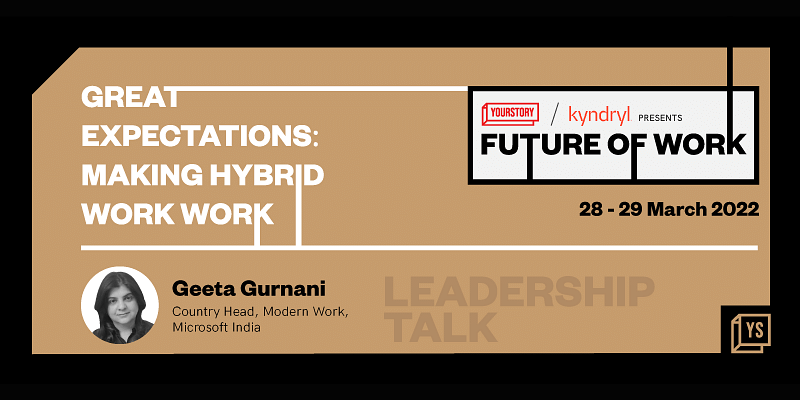One of the biggest challenges that organisations across the world are facing today, is to define and know how to make the hybrid work, work. Speaking at YS’s Future of Work Summit 2022, a two-day virtual conference bringing the best of minds in product, technology and design, Geeta Gurnani, Country Head, Modern work, Microsoft India, shared insights from Microsoft’s 2022 Work Trend Index.
The index outlines findings from a study of 31,000 people in 31 countries, along with an analysis of trillions of productivity signals in Microsoft 365 and labour trends on LinkedIn. The report covered several critical aspects such as the new role of the office, building social capital in a digital-first world, role of leaders, and more. Here are some key takeaways from the report and the leadership talk.
Employees have a new ‘worth it’ equation
The study suggests that the past two years of the pandemic have reshaped people’s priorities, identities, and worldviews, drawing attention towards pertinent conversations such as health, family, time, purpose, and more. As a result, employees’ ‘worth it’ equation – what people want from work and what they’re willing to give in return – has changed.
As per the study, 47 percent of respondents said they are more likely to put family and personal life over work than they were before the pandemic. In addition, 53 percent – particularly parents (55 percent) and women (56 percent) – said they’re more likely to prioritise their health and wellbeing over work than before.
Geeta highlighted that the leaders and organisations will need to create a culture that embraces flexibility and prioritises employee wellbeing.
Managers feel wedged between leadership and employee expectations
In the past two years, managers have emerged as a critical bridge between evolving employee expectations and leadership priorities. If empowered, they hold the key to unlock the potential of hybrid work. The study suggests many managers feel stuck between leadership and new employee expectations, and they feel powerless to drive change for their team.
Over half of managers (54 percent) feel leadership at their company is out of touch with employee expectations. And, 74 percent said they don’t have the influence or resources they need to make changes on behalf of their team.
“At Microsoft, we practise ‘model coach care’. It is how to model your own behaviour in terms of prioritising your well-being and health. The leaders need to decentralise decision-making and empower managers. We also follow team agreements for hybrid work as a best practice,” said Geeta.
Leaders must make the office worth the commute
The study suggests more than a third (38 percent) of hybrid employees say their biggest challenge is knowing when and why to come into the office.
“Defining the purpose of in-person collaboration, creating team agreements on when to come together in person, defining hybrid meeting etiquette, and rethinking how space can play a supporting role,” said Geeta, highlighting that organisations risk missing out on the true benefits of hybrid work if they miss out on these aspects.
Flexibility doesn’t have to mean ‘always on’
As per the index, since February 2020, the average Teams user saw a 252 percent increase in their weekly meeting time and the number of weekly meetings has increased 153 percent. The average Teams user sent 32 percent more chats each week in February 2022 compared to March 2020 and that figure continues to climb.
Geeta highlighted that the data indicates that employees are doing what they can to make flexible work their own but making flexible work sustainable long-term will require new team norms to guard against being “always on”.
Flexible work is reshaping the work day
“9am-11am was earlier the most used meeting time, but now 2pm-3pm is rising in popularity,” said Geeta, highlighting that through the data they are also able to identify the people who are attending the same meeting.
“If you and your managers and their second line managers are all attending the same meeting, it is actually counterproductive,” added Geeta. The study suggests that such aspects need attention if organisations are looking to minimise fatigue.
Geeta concluded by highlighting that the leaders will play the most critical role in embracing a culture of flexibility and prioritising employees’ wellbeing, empowering managers further, considering a mix of tech, space and culture, rebuilding social capital in a digital-first workforce, and creating new practices for sustainable flexible work.



![Read more about the article [Investor Summit 2021] Key takeaways from India’s first-of-its-kind summit](https://blog.digitalsevaa.com/wp-content/uploads/2021/04/Imagef4y9-1617209955080-300x150.jpg)






